Poor rover. I hope they had some rat shot rounds.
Barks & Bullets: The Story of S&W’s Bicycle Guns
Ammoland Inc. Posted on December 28, 2020 by Logan Metesh
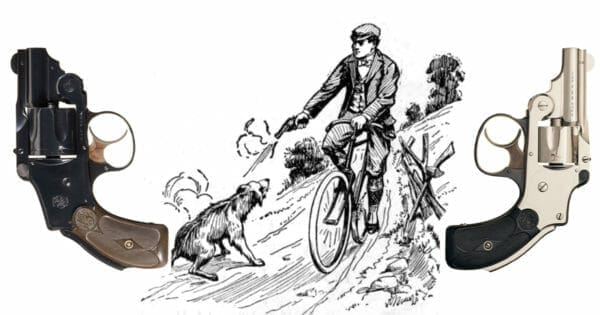 Barks & Bullets: The Story of S&W's Bicycle Guns
Barks & Bullets: The Story of S&W's Bicycle Guns
U.S.A. –-(AmmoLand.com)- The term “velocipede” may be foreign to most today, but it was familiar in 19th century Europe, where it was another way of referring to a bicycle. At the time, these unusual, human-propelled devices opened up a whole new world of possibility in terms of transportation. No longer did you need a horse (and all of the assorted expenses that come along with it) in order to travel faster than you could walk. This new mode of transport did, however, come with some drawbacks, mainly those of the four-legged variety: dogs.
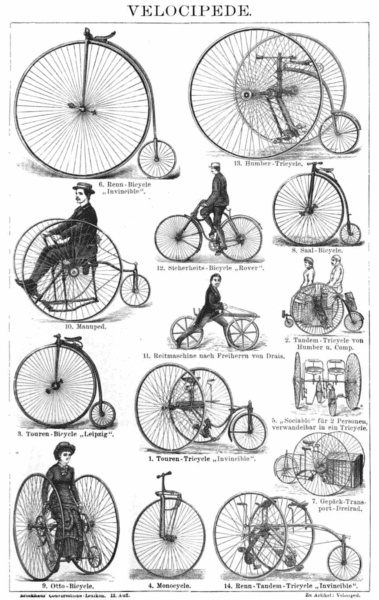 Ad for different types of velocipedes
Ad for different types of velocipedes
Just as dogs today chase cars because they’re unusual and scary, they also chased bicycles in the 19th century. Outrunning an angry dog in a car is easy, but if you’re traveling by velocipede, you can only escape as fast as you can pedal. For some, this was slower than a dog could run and the end result was an injury to the rider. Apparently, this happened frequently enough to spawn a new type of firearm with a new name that is familiar with gun collectors even today: the velo-dog revolver.
As the name suggests, a velo-dog revolver was designed to protect velocipedists against dogs when out for a ride. This kind of gun was made by a variety of different manufacturers over the years, but most have two main components in common: a concealed hammer and a short barrel. These pocket pistols were designed to be carried and drawn with ease, which was facilitated by the short barrel and lack of a hammer spur to get caught on one’s clothes.
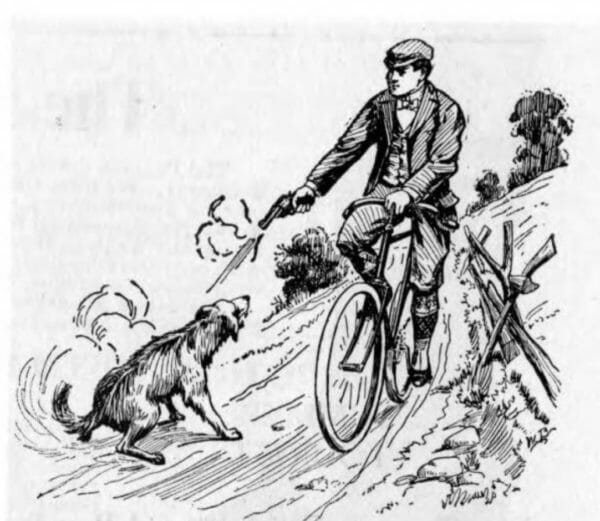 Imagery from a bicycle gun advertisement
Imagery from a bicycle gun advertisement
Smith & Wesson’s Safety Hammerless revolvers were introduced in 1887. They were an instant hit with consumers looking for a quality, concealable handgun that could be carried with ease. Looking to the success of the velo-dog in Europe, Smith & Wesson decided to offer something similar in the States. While “velocipede” was a common term in Europe, “bicycle” was much more prevalent in the United States. As such, Smith & Wesson chose “Bicycle Gun” as the name for these new Safety Hammerless revolvers with short barrels.
With barrels ranging anywhere from 1 ⅜-inch to 2.5-inches, bicycle guns were most often produced as small-batch, special order guns. Because of this they number far fewer than their longer-barreled counterparts and are much rarer and highly prized by collectors.
When new, a “bicycle gun” cost of $26.50, but they'll set you back considerably more today. Let's take a look at a couple of examples that sold at Rock Island Auction Company in 2019.
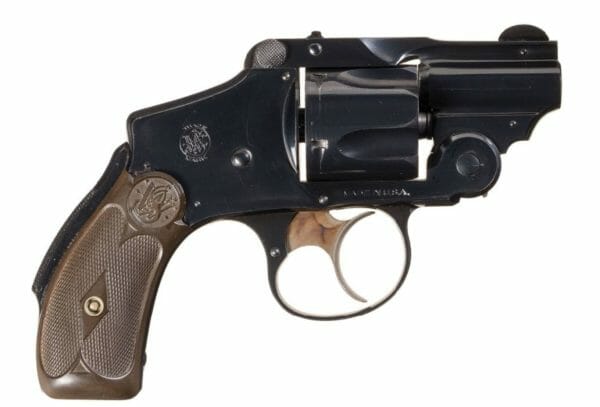 Blued S&W “bicycle gun” (Rock Island Auction Co)
Blued S&W “bicycle gun” (Rock Island Auction Co)
One of the guns was a blued example with a 1.5-inch barrel that is believed to be one of approximately 15 made with pinned front sights, which are not found on the rest of the 5th Model variations of this gun. The Standard Catalog of Smith & Wesson notes that 5th Model guns with 2-inch barrels will bring a 100% premium over the standard lengths. The 1.5-inch guns are even more rare, noting them to be “worth substantial premium [sic].”
It’s hard to explain just how rare this gun is, so here’s a bit of simple math. There were 41,500 5th Model guns made, and only 15 in this specific configuration. If all of them survive (which they likely don’t), they make up just 0.0003% of all the Safety Hammerless 5th Models ever produced. The auction estimate was $2,750 to $4,000 and it sold well above that, hammering at $6,900.
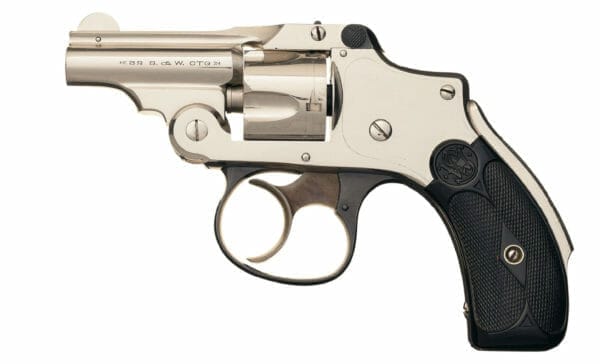 Nickel S&W “bicycle gun” (Rock Island Auction Co)Another bicycle gun in that same sale, this time with a 2-inch barrel and nickel finish, had an estimate of $1,800 to $2,750. The final price was $4,025.
Nickel S&W “bicycle gun” (Rock Island Auction Co)Another bicycle gun in that same sale, this time with a 2-inch barrel and nickel finish, had an estimate of $1,800 to $2,750. The final price was $4,025.
Because of their high value, many fakes have been made over the years by skilled gunsmiths cutting down longer barrels and reattaching the front sights. The surest way to verify the authenticity of a bicycle gun is through a factory letter. It might seem like another added expense, but it will be well worth it regardless of the outcome. If the gun is legit, you just added to the value. If it's a well-made fake, then you just saved yourself thousands of dollars.
Barks & Bullets: The Story of S&W’s Bicycle Guns
Ammoland Inc. Posted on December 28, 2020 by Logan Metesh

U.S.A. –-(AmmoLand.com)- The term “velocipede” may be foreign to most today, but it was familiar in 19th century Europe, where it was another way of referring to a bicycle. At the time, these unusual, human-propelled devices opened up a whole new world of possibility in terms of transportation. No longer did you need a horse (and all of the assorted expenses that come along with it) in order to travel faster than you could walk. This new mode of transport did, however, come with some drawbacks, mainly those of the four-legged variety: dogs.

Just as dogs today chase cars because they’re unusual and scary, they also chased bicycles in the 19th century. Outrunning an angry dog in a car is easy, but if you’re traveling by velocipede, you can only escape as fast as you can pedal. For some, this was slower than a dog could run and the end result was an injury to the rider. Apparently, this happened frequently enough to spawn a new type of firearm with a new name that is familiar with gun collectors even today: the velo-dog revolver.
As the name suggests, a velo-dog revolver was designed to protect velocipedists against dogs when out for a ride. This kind of gun was made by a variety of different manufacturers over the years, but most have two main components in common: a concealed hammer and a short barrel. These pocket pistols were designed to be carried and drawn with ease, which was facilitated by the short barrel and lack of a hammer spur to get caught on one’s clothes.

Smith & Wesson’s Safety Hammerless revolvers were introduced in 1887. They were an instant hit with consumers looking for a quality, concealable handgun that could be carried with ease. Looking to the success of the velo-dog in Europe, Smith & Wesson decided to offer something similar in the States. While “velocipede” was a common term in Europe, “bicycle” was much more prevalent in the United States. As such, Smith & Wesson chose “Bicycle Gun” as the name for these new Safety Hammerless revolvers with short barrels.
With barrels ranging anywhere from 1 ⅜-inch to 2.5-inches, bicycle guns were most often produced as small-batch, special order guns. Because of this they number far fewer than their longer-barreled counterparts and are much rarer and highly prized by collectors.
When new, a “bicycle gun” cost of $26.50, but they'll set you back considerably more today. Let's take a look at a couple of examples that sold at Rock Island Auction Company in 2019.

One of the guns was a blued example with a 1.5-inch barrel that is believed to be one of approximately 15 made with pinned front sights, which are not found on the rest of the 5th Model variations of this gun. The Standard Catalog of Smith & Wesson notes that 5th Model guns with 2-inch barrels will bring a 100% premium over the standard lengths. The 1.5-inch guns are even more rare, noting them to be “worth substantial premium [sic].”
It’s hard to explain just how rare this gun is, so here’s a bit of simple math. There were 41,500 5th Model guns made, and only 15 in this specific configuration. If all of them survive (which they likely don’t), they make up just 0.0003% of all the Safety Hammerless 5th Models ever produced. The auction estimate was $2,750 to $4,000 and it sold well above that, hammering at $6,900.

Because of their high value, many fakes have been made over the years by skilled gunsmiths cutting down longer barrels and reattaching the front sights. The surest way to verify the authenticity of a bicycle gun is through a factory letter. It might seem like another added expense, but it will be well worth it regardless of the outcome. If the gun is legit, you just added to the value. If it's a well-made fake, then you just saved yourself thousands of dollars.

